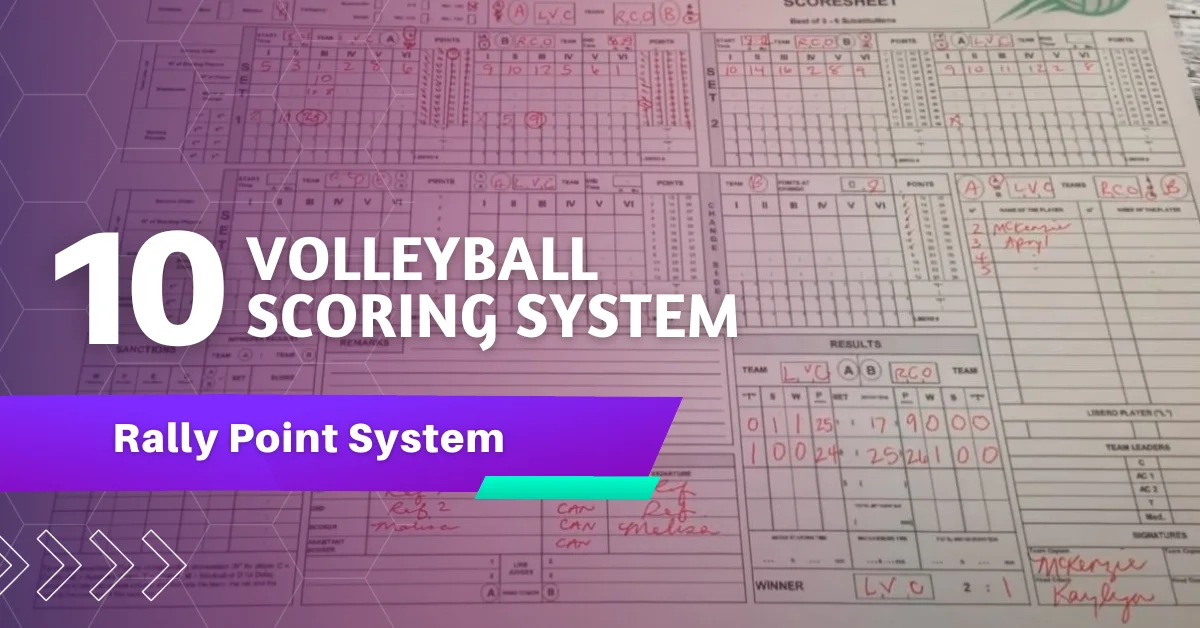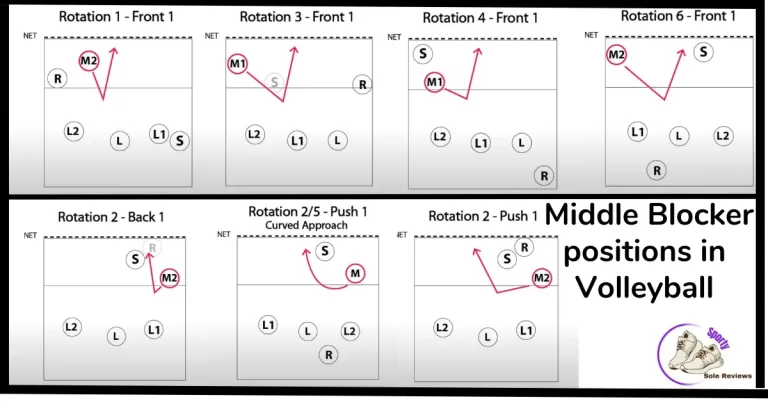Volleyball Scoring System – Understand the Rally Point System
Scoring points in volleyball is the heartbeat of the game, igniting excitement and shaping victory. Volleyball is a dynamic team sport played on a rectangular court with teams of six players on each side. The objective is to score points by grounding the ball in the opponent’s court or forcing an error. From soaring spikes to cunning feints, each point scored showcases skill and teamwork.
As a USA school tournament player, I create a Training Intensity Calculator for my junior players to see their position in the game and how they can enhance their game. Players and trainers can read this.
Volleyball Scoring System| Team | Set 1 | Set 2 | Set 3 | Set 4 | Set 5 | Total |
|---|---|---|---|---|---|---|
| Team A | 0 | 0 | 0 | 0 | 0 | 0 |
| Team B | 0 | 0 | 0 | 0 | 0 | 0 |
Understanding Volleyball Scoring system
In the volleyball scoring system, there exists a fascinating duality between set points and match points. It’s imperative to fathom the distinctions that set them apart and their profound influence on the ebb and flow of the game.
Set Points vs. Match Points
Set points and match points are two distinct facets of volleyball scoring, each with its own role in shaping the outcome of a match.
Set Points: Microcosms of the Battle
Set points decide the victor of individual sets within a match. Typically, a team needs to amass 25 points (with a two-point lead) to clinch a set, although this criterion can vary based on the level of competition.
Match Points: The Ultimate Triumph
In contrast, match points determine the winner of the entire contest. To secure victory in the match, a team must claim the majority of sets, usually the best of five. This could mean winning three sets to one or all five if it’s a closely contested showdown.
The Narrative Building Blocks
Sets function as chapters in the story of a volleyball match. Each set offers teams an opportunity to seize control or stage a comeback. The seesaw battle for supremacy, set by set, often leads to thrilling shifts in momentum.
Rally Scoring vs. Side-Out Scoring
The realm of volleyball scoring has seen the emergence of two primary systems: rally scoring and side-out scoring, each with its own set of advantages and drawbacks.
Rally scoring: quick and thrilling
Rally scoring allocates points on every rally, regardless of the serving team. This system injects urgency into every play, resulting in a fast-paced and exhilarating experience. However, it can also lead to longer matches.
Side-Out Scoring: Emphasis on Strategy
Historically prevalent, side-out scoring rewards points exclusively to the serving team. This system prioritizes service accuracy and strategic finesse. While it can lead to more methodical matches, it also demands precision and resilience.
The Evolution of Volleyball Scoring
The evolution of volleyball scoring mirrors the sport’s quest for equilibrium between entertainment and strategy. From the traditional roots of side-out scoring to the adoption of rally scoring, volleyball continuously adapts to ensure that every point holds significance and keeps spectators enthralled.
Navigating Tiebreakers
Within the intricate landscape of the volleyball scoring system, tiebreakers emerge as the defining moments that can shift the tides of a match. As a volleyball player, I serve many resources, and I tell you about the art of navigating tiebreakers, where victory hinges on the delicate balance of skill, strategy, and mental fortitude.
When Sets Are Tied
When two competitive teams find themselves with sets evenly split, the atmosphere in the arena electrifies. It’s a testament to the closely-matched contest, and this is precisely when tiebreakers come into play, injecting an extra dose of adrenaline into the proceedings.
How Tiebreakers Work
Tiebreakers, often played to a set number of points, typically 15, although this may vary depending on the level of competition, create a pressure cooker environment. Each rally becomes a make-or-break moment, demanding unwavering focus and pinpoint execution.
Importance of Momentum in Tiebreakers
Momentum, a coveted and elusive companion in tiebreakers, can be a game-changer. A single powerful serve, a perfectly executed spike, or a crucial defensive dig can tip the scales dramatically. Players must harness momentum, much like a surfer riding a wave, to seize control of the tiebreaker and carry it forward.
Understanding the 5th Set Tiebreaker
In some formats, the 5th set serves as the ultimate tiebreaker. It operates under unique rules and strategies, often requiring teams to switch sides of the court when a team reaches eight points. This set is a test of endurance, mental fortitude, and adaptability, as teams must quickly adjust to the changing court conditions.
Unique Rules and Strategies
In tiebreakers, every point becomes precious, and the margin for error diminishes. Teams must serve strategically, defend resolutely, and attack with precision. It’s a chess match with a volleyball, where the right move at the right time can secure victory. Strategies like targeting weak rotations or exploiting blocking mismatches often come into play, adding a cerebral dimension to the game.
Winning the Match with a 5th Set Victory
In the grand scheme of a volleyball match, the 5th set tiebreaker can be the dramatic climax, a crescendo that leaves an indelible mark on both players and spectators. Winning this set not only secures the match victory but also serves as a vivid reminder of the thrilling unpredictability that lies at the heart of the volleyball scoring system. It’s a testament to the sport’s capacity to deliver edge-of-your-seat excitement until the very last point.
Common Scenarios and Strategies
In the intricate realm of the Volleyball Scoring System, achieving victory often depends on how teams navigate common scenarios and employ strategic brilliance.
Winning a Set with a Margin
Two-Point Advantage Rule
Winning a set isn’t just about reaching the 25-point mark. The Two-Point Advantage Rule demands a margin. A team must be two points ahead to secure a set. This rule intensifies the battle for set points, making precision and strategy paramount.
Strategic Considerations for Set Point
Reaching set point is a critical juncture. Teams must strategize meticulously, exploiting opponents’ weaknesses and capitalizing on their own strengths. It’s a chess match within a set, where a well-executed plan can tilt the scales.
The Importance of Consistency
Maintaining Control through Consistent Scoring
Consistency is the bedrock of volleyball success. Consistently scoring points not only builds confidence but also exerts psychological pressure on the opposition. Teams that can string together points methodically often emerge victorious.
Avoiding Unforced Errors
In the high-stakes arena of volleyball, unforced errors can be fatal. Teams must cultivate the art of error reduction, minimizing mistakes in serves, attacks, and passes. Every point counts, and unforced errors can be costly.
Psychological Aspects of Scoring
Dealing with Pressure
The mental game in volleyball is just as critical as physical skills. Dealing with Pressure becomes pivotal during crucial points. Remaining composed under pressure, staying focused, and managing nerves are skills that can tip the balance.
Team Dynamics and Communication
Effective communication and seamless Team Dynamics are indispensable. Players must synchronize their movements, read each other’s intentions, and maintain a cohesive unit. Miscommunication can lead to scoring lapses and disrupt momentum.
Mastering these common scenarios and strategies within the Volleyball Scoring System is akin to wielding a finely tuned instrument. It’s the art of turning pressure into performance, errors into opportunities, and teamwork into triumph.
Conclusion
In this topic of the Volleyball Scoring System, I uncovered the intricacies that define this dynamic sport. It’s a world where points are not mere numbers; they’re the heartbeat of strategy and competition. Embracing this complexity is key to truly appreciating the competitive spirit that fuels volleyball.
What is the scoring system in volleyball?
The scoring system in volleyball follows the rally scoring format, where a point is awarded after every rally, regardless of which team serves. The team that wins a rally scores a point and continues to serve.
How can I improve my serving skills for scoring points?
To enhance your serving skills, practise different types of serves such as topspin and float serves. Focus on consistent and powerful serves by perfecting your form, footwork, and ball contact.
What defensive strategies can I use to score points in volleyball?
Defensive tactics like effective blocking and digging are crucial. Study opponents’ strengths and weaknesses, anticipate attacks by reading hitters’ body language, and swiftly transition from defence to offence for counterattacks.
How can I make in-game adjustments to improve scoring opportunities?
During the game, keenly observe opponents and your team’s performance. Make tactical adjustments based on your observations, utilise timeouts strategically, and implement timely substitutions for a competitive advantage.
What role does continuous improvement play in scoring success?
Continuous improvement is vital for honing skills and staying ahead in the game. Regular practice, analysing game footage, and seeking feedback from coaches and teammates can help elevate your scoring abilities and overall performance in volleyball.








